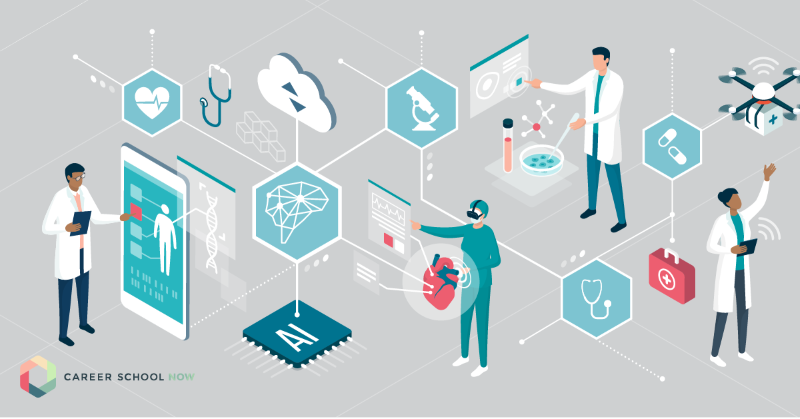The Future of Medical Administration: Trends and Advancements to See
The Future of Medical Administration: Trends and Advancements to See
Blog Article
Ideal Practices in Medical Management for Improving Effectiveness and Minimizing Expenses
In the ever-evolving landscape of health care, the quest of best techniques in clinical administration is critical for enhancing performance and suppressing expenses. By integrating innovative innovations such as electronic wellness records and telemedicine, doctor can improve procedures and enhance person treatment. Modern technology alone is not a remedy; maximizing source appropriation and promoting joint interaction among treatment teams are similarly vital. As organizations strive to stabilize top quality and price, what strategies should be focused on to attain these dual objectives? The answers to these concerns hold the trick to a more lasting medical care system.
Leveraging Advanced Technology
In today's quickly progressing medical care landscape, leveraging advanced innovation is no more optional yet essential for efficient medical administration. The assimilation of electronic remedies right into healthcare systems has transformed the method facilities run, simplifying processes and enhancing client care. Electronic Health And Wellness Records (EHRs) are crucial, supplying comprehensive patient data that can be accessed quickly by accredited employees, hence decreasing redundancy and reducing errors. By systematizing individual details, EHRs remove the requirement for troublesome documents and help with seamless interaction amongst medical care carriers.
Telemedicine is one more technological innovation that has actually changed individual communication. It provides ease for both patients and health care experts by allowing remote assessments, which can lower the requirement for in-person gos to and maximize visit organizing. Furthermore, telehealth systems can prolong medical care access to country or underserved areas, connecting gaps in care distribution.
Additionally, the usage of Artificial Intelligence (AI) and equipment knowing is coming to be increasingly prevalent in anticipating analytics, permitting early discovery of potential health and wellness concerns and more educated decision-making. These modern technologies, when integrated successfully, can boost diagnostic accuracy and customize person treatment plans, eventually leading to improved health care end results and operational effectiveness.
Optimizing Source Appropriation
Effective resource allowance is crucial for making best use of the efficiency of medical administration. By tactically taking care of resources such as personnel, devices, and financial resources, medical care centers can considerably improve their functional efficiency, enhance individual end results, and lower unneeded expenditures. The very first step in enhancing source allowance involves conducting an extensive evaluation of current properties and recognizing locations where sources may be underutilized or overextended. This evaluation ought to be data-driven, utilizing metrics and analytics to inform decision-making processes.
Prioritizing source allocation based on person demands and solution demands is essential. This entails lining up resources with high-demand locations, such as emergency treatment or specialized treatments, to guarantee prompt and efficient patient treatment. Executing adaptable staffing designs can also maximize labor resources by readjusting personnel appropriation in reaction to rising and fall individual volumes. Furthermore, embracing telemedicine and various other technical services can alleviate physical source constraints by using alternative opportunities for patient-provider communications.
Funds need to be carefully kept an eye on and allocated with calculated insight to support both short-term functional needs and long-lasting institutional goals. This includes investing in training programs that improve team expertises and adopting energy-efficient methods that lower functional costs (medical administration). Ultimately, an optimized resource allowance approach promotes a sustainable health care setting that is receptive, efficient, and financially prudent
Streamlining Process Processes
When healthcare facilities aim to enhance operational effectiveness, enhancing process processes ends up being a critical focus. Effective process lessen redundancy, get rid of unneeded steps, and improve sychronisation amongst health care experts. This technique not just speeds up service shipment but also boosts the top quality of individual treatment.

Following, modern technology assimilation plays a substantial role in improving operations. Applying digital health documents (EHRs) and computerized medical professional order entry (CPOE) systems minimizes paperwork, reduces human mistake, and makes sure details comes to all appropriate workers. Furthermore, leveraging telemedicine platforms can enhance patient consultations and follow-ups, minimizing the stress on physical facilities.

Eventually, structured operations cause set you back decreases and enhanced client complete satisfaction, promoting a more sustainable health care setting.
Enhancing Information Monitoring
Structure upon streamlined operations, optimizing data management comes to be an essential element in progressing medical care administration. Efficient information management systems are critical for preserving precise person documents, enhancing decision-making, and making sure conformity with regulative standards. By executing robust data administration remedies, medical care centers can improve the quality of patient treatment while at the same time reducing operational prices.
One key element of improving data management is the combination of advanced electronic health and wellness record (EHR) systems. These systems facilitate the Homepage seamless exchange of client information throughout different divisions, decreasing replication of examinations and minimizing errors. A well-designed EHR system sustains information analytics, making it possible for medical care providers to identify fads and make informed choices concerning patient treatment.
Moreover, safeguarding patient information is paramount. Adopting thorough cybersecurity measures, consisting of encryption and routine audits, makes certain the integrity and discretion of sensitive details. This not just shields individuals yet additionally preserves the institution's track record.
Purchasing personnel training is an additional vital aspect. Enlightening healthcare specialists on information administration techniques improves their capacity to effectively utilize technology, leading to enhanced client outcomes. To conclude, boosting data monitoring via innovative technology and extensive training is essential for achieving efficiency and cost decrease in clinical administration.
Fostering Collaborative Interaction
A crucial element ahead of time medical administration is promoting collaborative interaction among health care specialists. Effective communication is critical for making sure smooth individual care, optimizing treatment results, and minimizing mistakes. By encouraging open discussion and sychronisation across multidisciplinary groups, medical care companies can enhance their operational efficiency and reduce unneeded expenses.
Central to this method is the integration of communication innovations such as electronic wellness records (EHRs) and safe and secure messaging systems, which promote the rapid exchange of important individual info. These tools make it possible for doctor to accessibility and share information in real time, making certain that all team participants are notified and aligned in their decision-making procedures. Additionally, regular group meetings and interdisciplinary rounds can better promote a society of partnership and accountability.
Training programs concentrated on improving interaction abilities are site web also important. Ultimately, fostering collaborative interaction leads to boosted medical care distribution and price savings.

Final Thought
Including innovative innovation, such as electronic health and wellness records and telemedicine, alongside optimized source appropriation and streamlined process processes, is crucial for boosting efficiency in medical administration. Reliable information management and cultivating collective communication among medical care teams are critical for minimizing redundancies and boosting care quality. By focusing on preventative treatment and involving in top quality enhancement initiatives, medical care organizations can accomplish significant price savings and improved client results, consequently making sure sustainable healthcare shipment in an increasingly intricate environment.
Report this page